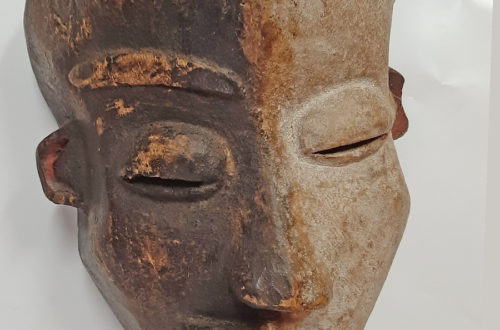Q: My uncle bought this in Africa in 1969. Sadly, one horn is broken and has a metal staple holding it together. Not sure when it broke, probably years ago. It’s 17 by 10.5 inches. David, 1503
A: Goli masks from the Ivory Coast are a favorite of tourists and collectors. They never represent the ancestors and are always worn by men.
Goli is the day-long spectacle that normally involves the whole village and includes the appearance of four pairs of masks, music played on special instruments, and, ideally, the joyous consumption of a great deal of palm wine. Goli can be performed both as an entertainment and for the funeral of important men. The very characteristic, round-shaped lunar goli is surmounted by two horns. It was borrowed from the Wan for a celebration adopted by the Baule after 1900. Celebrating peace and joy, they would sing, dance, and drink palm wine. In the procession, the goli preceded the four groups of dancers, representing young adolescents. The goli would be used on the occasion of the new harvest, the visit of dignitaries, or at the funerals of notables.
The goli kplekple mask is one of several that appear in the Goli spirit dance. It represents a minor spirit associated with the junior rank of male dancers who perform before the more important masks appear. In keeping with its low status, this mask is made in a simple disk-shaped design and lacks the more complex form and ornamentation that the Baule admire in their important masks. Considered a mischievous mask, the youthful dancer playfully chases young women around the village, goaded by their songs.
This one looks hardly used and might have been made for sale to tourist. Maybe one of our visitors can tell if it is authentic or not.








